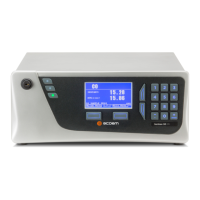TÜV Rheinland Energie und Umwelt GmbH
Luftreinhaltung
Report on the performance testing of the Serinus 30 ambient air quality moni-
toring system manufactured by Ecotech Pty Ltd measuring CO, Report no.:
936/21221977/D_EN
EP_Ecotech_Serinus30_en.docx
3. Description of the analyser tested
3.1 Measuring principle
The Serinus 30 measuring system is a continuous carbon monoxide monitor which uses the
method of non-dispersive infrared photometry. The instrument is designed for the continuous
measurement of carbon monoxide concentrations in ambient air.
Figure 1: Representation of the Serinus 30 analyser
The Serinus 30 carbon monoxide analyser uses the method of non-dispersive infrared pho-
tometry to measure carbon monoxide in the range of 0 – 200 ppm. Measurements are made
by means of the following components:
microprocessor control
proven Gas Filter Correlation (Gfc)
combined with Non-Dispersive Infrared Spectrophotometry (NDIR) technology
The CO concentration is automatically corrected for gas temperature and pressure changes
and referenced to 0 °C, 20 °C or 25 °C at 1 atmosphere. This allows the Serinus 30 to accu-
rately measure CO in all ambient applications.
Carbon monoxide is measured on the basis of the following principles and methods:
CO absorbs infrared radiation (IR) at a wavelength of approx. 4.7 µm. IR radiation (at 4.7 µm)
passes through the sample air with the measurement path being 5 m. According to the Beer-
Lambert law, the intensity of the received signal is proportional to the CO concentration with-
in the sample. In order to make sure that only light at a wavelength of 4.7 µm is let through; a
band-pass filter is attached to the signal detector.
The Beer-Lambert equation is used to calculate the gas concentration from the ratio of two
measured light intensities:
I/I
0 = exp (-acd)

